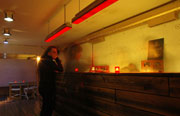BRUT HISTORY
brut im Künstlerhaus

brut im Konzerthaus
After the opening of the Wiener Konzerthaus in 1913, one of the cellars housed one of three restaurants, which belonged to the concept of the house but became insolvent after a few years. Since the 1950s – the golden era of the Wiener Kellertheater [Viennese Cellar Theatre] – the Konzerthaus cellar was used for theatre and cabaret. For two decades, from 1957 to 1977, the Theater in der Josefstadt ran the Kleine Theater im Konzerthaus here, guest-starring Helmut Qualtinger among others. Between 1977 and 1981, the Ensemble Theater under the directorship of Dieter Haspel Mieter performed in the Konzerthaus, from 1981 to 1987 the Volkstheater organised in the Konzerthaus-Keller the VT-studio.
dietheater
As a common umbrella organisation for the Künstlerhaus- and the Konzerthaus-theatres, on 31 January 1989, the dietheater venue was founded as representative body of the Theaterverein Wien under the artistic direction and management of Christian Pronay. From 1989 to 2007, dietheater was a venue for independent Austrian theatre groups and primarily staged productions by Viennese artists. With the “imagetanz” festival, taking place from the beginning, dietheater also provided a major platform for the Viennese dance scene.
dietheater becomes brut
In the summer 2006, the Theaterverein Wien invited new applications for the artistic direction of the two venues in the Künstlerhaus and Konzerthaus. With their concept, Thomas Frank and Haiko Pfost won the application procedure and on 20 November 2006 were finally designated as new artistic directors by the city councillor for cultural affairs Dr. Andreas Mailath–Pokorny.
The new beginning of the house is marked both by its reconstruction and the change of name. The name brut is a find: it stood in large letters on the back wall of the bar in the Konzerthaus. The range and the contradictoriness of the meanings associated with the term represent openness and processuality of the artistic work of the Koproduktionshaus Wien.
Reconstruction
On the occasion of the new opening, the venues were also reconstructed. Brut in the sense of raw, unplastered, became the guiding concept of the reconstruction measures. And this is how brut im Künstlerhaus presented itself after the refurbishment, when the layers under the smooth, all too cool metal wall coverings and veneers became visible again.
The group konstantin gabel – Ece Anisoglu, Jakob Brossmann, Julia Miglinci and Johannes Weckl – four students of the class for stage and film design at the University of Applied Arts Vienna, developed the refurbishment concept for brut together with the architects Gabu Heindl and Manfred Hasler and in close cooperation with the new artistic direction. The audience area was changed and a completely new bar was built, which commenced operations on the occasion of the brut opening in November 2007. The emphasis was on the idea of creating multifunctional, adaptable spaces whose usability was not clearly predetermined. The culture of smooth service is confronted with crude, haptic rooms. The house, in the broadest sense still incomplete, understands itself as a permanent invitation to capture the space and turn it into the site of a discourse. Old materials instead of a designed décor as well as found materials were recycled and transformed, covered-over structures were exposed and made visible.
After the appointment of Thomas Frank and Haiko Pfost as new artistic directors and the preparation time in the months from January to November 2007, brut was opened on 9 November 2007 within the framework of a two-day event.




















